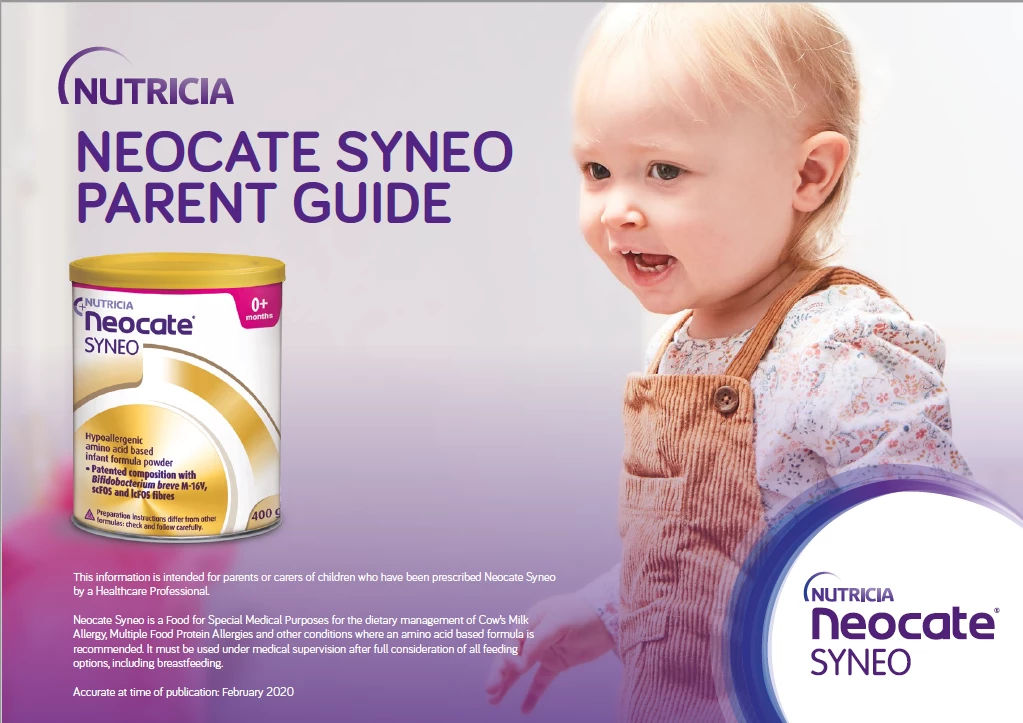Are you looking for guidance on how to support parents of infants with Cow's Milk Allergy (CMA), who are starting solids for the first time?
This article will provide evidence-based guidance that considers the specific nutritional requirements of CMA infants and addresses common questions and worries that parents may have.
This article has been authored by Bahee Van De Bor, a specialist paediatric dietitian.
Introducing solids to an infant with CMA
CMA is a prevalent condition affecting 2-3% of infants and young children in the UK, but most children outgrow it by the age of five.
Parents of infants diagnosed with CMA can feel anxious when introducing solid foods, but the good news is that the approach to weaning CMA infants is virtually identical to non-allergic infants1 apart from a few key points.
Nevertheless, it’s important to encourage parents to read labels carefully to ensure that complimentary solids are free from cow’s milk protein. This can increase parental confidence when introducing solids to their baby.
Although parents may be eager to start solids early, the Department of Health recommends delaying the introduction of solids until babies are 6 months old, and not before 4 months of age. Experts also recommend introducing all dairy-free solid foods one at a time to check for tolerance and potential food allergies.
Despite this, some babies may become developmentally ready to start solids earlier than 6 months. For this reason, it’s important that parents check for the following signs of readiness before starting dairy-free weaning2:
- Baby can stay in a sitting position and hold their head steady
- They can coordinate their eyes, hands and mouth so they can look at the food, pick it up and put it in their mouth by themselves.
- Be able to swallow food (rather than spit it back out)
What first foods are suitable for infants with CMA?
Traditionally, parents may have been advised to start with baby cereals as the first weaning food, but current weaning advice recommends starting with vegetables, then fruit, starchy foods and iron-rich foods like lentils, legumes, meat, chicken and fish.
Encourage parents to start with bitter and sour flavours of vegetables such as broccoli and green beans or root vegetables like carrots to increase familiarity and acceptance of bitter flavours.
Once the infant becomes accustomed to these tastes, parents can introduce sweeter flavours of fruits like cooked apples, bananas or soft elongated pieces of pear.
Weaning at 4 or 5 months of age
For infants starting solids before six months of age, parents should begin with a thin puree of vegetables and then fruit.
It’s important to remind parents that solids should only be introduced when the baby is developmentally ready. This helps to minimise the risk of choking and prevent hospital admissions for gastrointestinal and respiratory infections.
Introducing high-allergenic foods
The UK Department of Health recommends introducing all high-allergenic foods like eggs, peanuts, nuts and gluten from six to 12 months of age.
However, parents should avoid giving whole or crushed nuts to children under five years of age due to the risk of choking. Instead, smooth peanut butter can be thinned with breastmilk, hot water or baby’s specialist hypoallergenic formula.
When it comes to soya protein, up to 50-60% of babies with delayed CMA may also react to soya. This is more prevalent in babies with non-IgE mediated CMA than in those with IgE mediated allergies.
Parents should, therefore, consult with their paediatric dietitian and allergy specialist for guidance on whether soya needs to be excluded from their infant’s diet.
Guidance for infants at higher risk of food allergy
Infants with eczema, especially early-onset or moderate to severe eczema, are at higher risk of developing a food allergy3.
To reduce this risk, research suggests introducing solids containing eggs and peanuts from 4 months of age, alongside other complementary foods as outlined above3.
When serving hen eggs, these should be well cooked until both the white and yolk are solid. If the eggs carry the red lion stamp, they can be served lightly cooked4.
Dairy-free baby-led weaning
At around 6 months of age, infants can begin transitioning from pureed or blended foods to mashed, lumpy, or finger foods.
Parents who prefer baby-led weaning can skip straight to soft finger foods from 6 months. Steamed vegetables can be a good starting point as infants can easily pick them up with their hands and bring them to their mouths.
As infants begin to enjoy fruits and vegetables, parents can introduce porridge fingers or slices, lightly toasted bread with mashed avocado, and other firm but soft foods to make it easier for the infant to pick them up. Foods should also be sliced lengthwise to reduce the risk of choking.
Cow’s Milk Allergy weaning plan
| Age | Plan |
| Age 4-6 months | If parents choose to start complementary solids and the infant is developmentally ready, start with a smooth, thin puree of vegetables and then fruit. ● Suitable vegetables include broccoli, courgette, peas, green beans and carrots to list a few. ● Next introduce pureed fruit like apples, pears, well-mashed bananas, peaches and avocados. ● If advised to offer egg and peanut, then introduce after vegetables and fruit. ● Breastfed infants should be given daily 8.5-10 ugs of vitamin D drops from birth. |
| From 6 months | ● Can start with puree or steamed vegetables that are soft so that it’s easy for the infant to pick up with their hands and easily mash in the mouth. ● Next add starchy foods like potatoes, oats, rice, and pasta. ● Parents can offer porridge oats for breakfast which can be prepared using breastmilk, baby’s specialist infant formula or a calcium and iodine-fortified soy*, oat or coconut plant drink. ● Introduce smooth peanut butter thinned using breastmilk, hot water or specialist formula. Can be added to porridge. ● Introduce iron-rich foods like boiled lentils, pureed meat, chicken and fish or cook until very soft so that baby can easily mash the food in their mouth. ● Introduce well-cooked eggs such as scrambled eggs for breakfast. ● Breastfed infants should start daily vitamins A, C and D drops. |
| 7-9 months | ● Continue to expand the range of solids and texture. ● By now infants should be tolerating lumpier textures from meals providing a variety of textures where vegetables, lentils, fish and chicken might be chopped or mashed to encourage the baby to chew. ● Gradually move onto harder finger foods. |
*parents to seek personalised guidance from their paediatric dietitian and allergy specialist regarding soya protein
Common Cow’s Milk Allergy weaning questions
To help parents avoid cow’s milk in their infant’s diet when purchasing food, advise them to carefully read food labels. In the UK, all packaged foods list their ingredients, with any presence of cow’s milk protein highlighted in bold.
Inform parents that if a product includes milk, then words like casein, whey, lactose, cream and non-fat milk solids indicate that the food item is not suitable. A paediatric dietitian will provide teaching materials and lists of foods to avoid on a milk-free diet.
It’s important to note that some vegan or plant-based products may contain dairy, so double-checking the ingredients list is necessary.
Unless the infant has a severe allergy to cow’s milk protein, products labelled ‘may contain traces’ do not need to be avoided. If parents are unsure, they should consult with their paediatric dietitian.
Parents can use ‘allergy-free’ cookbooks or ask their dietitian for help modifying recipes. Fortified foods such as calcium and iodine-fortified oat, soy or coconut yoghurt and plant drink alternatives can be excellent milk substitutes for dairy-free cooking.
Mothers who breastfeed infants with CMA are advised to take a daily vitamin D supplement of 10 ugs and start vitamin D drops for the baby from birth. Additionally, the mother’s calcium requirements increase to 1250 mg per day.
Breastfeeding women can meet their calcium requirements by including calcium-fortified foods and calcium-rich foods.
Examples are:
- oranges
- calcium-set tofu
- fortified plant drink alternatives and yoghurt
- calcium-fortified bread
- tinned fish with bones
- broccoli
- kale
- spring greens5
However, if these foods are not consumed daily or in sufficient quantities, a calcium supplement may be necessary.
Infants who are allergic to fish may have lower iodine intake. Iodine is a nutrient essential for the normal development of the brain and thyroid hormones6.
To ensure that the infant is getting sufficient iodine, breastfeeding mothers should make sure that they are meeting their daily iodine requirements of 250 ug with a supplement if indicated.
Iodine food sources include specific brands of fortified plant drinks, yoghurt and seaweed.
For the infant, if parents choose to offer a specialist infant formula when breast milk is not available, then this is an additional source of iodine.
For mothers who cannot breastfeed, hypoallergenic infant formula is the only suitable alternative. It contains all the necessary nutrients for infant growth and development.
For CMA, an extensively hydrolysed protein formula (EHF) is typically recommended. While EHF formulas break down cow’s milk proteins into small fragments to reduce the likelihood of an allergic reaction, some infants may still react to larger fragments.
In such cases, switching to an amino acid-based formula may be necessary for complete symptom resolution.
Although infant formula is fortified with all the necessary vitamins and minerals, once the infant is drinking less than 500ml of formula per day, daily vitamins A, C and D drops should be commenced and continued until five years of age7.
CMA infants can be more prone to fussy eating and feeding difficulties8 compared to those consuming an unrestricted diet. For this reason, it’s important to move swiftly onto lumpy textures and finger foods once the baby is confidently managing puree.
Encourage parents to avoid delaying lumpy, mashed or finger foods which can be introduced from six months.
Monitoring the nutritional status of an infant with CMA is important to ensure they are growing and developing appropriately. The child’s weight and length should be regularly measured and plotted on UK-WHO percentile growth charts to track their growth trajectory.
If the infant demonstrates signs of faltering growth or is not meeting their normal growth pattern, a referral to a paediatric dietitian should be made.
CMA infants may be at increased risk of developing other food allergies.
Despite this, delaying the introduction of high-allergenic foods can increase the infant’s risk of developing allergies to those foods. As such, high-allergenic foods should be introduced as part of a varied and balanced diet, following the recommended BSCAI guidelines for healthcare professionals when introducing solids3.
Whilst allergy tests may be helpful in some cases, waiting for allergy tests can unnecessarily further delay the introduction of these foods.
If parents notice any signs of a new food allergy such as hives, swelling, or difficulty breathing, they should stop offering the food and seek medical attention.
- Scientific Advisory Committee Nutrition (SACN). Feeding in the First Year of Life. 2018.[internet] [cited 2023 March 11]. Available from:Feeding in the first year of life: SACN report - GOV.UK (www.gov.uk)
- NHS. Your Baby’s First Solid Foods. [updated 2022 October 3; cited 2023 March 11] Available from: https://www.nhs.uk/conditions/baby/weaning-and-feeding/babys-first-solid-foods/
- BSACI. Preventing food allergy in higher risk infants: guidance for healthcare professionals. [updated 2018 May; cited 2023 March 11]. Available from: Infant feeding and allergy prevention FINAL (bsaci.org)
- NHS. Foods to avoid giving babies and young children. [updated 2022 August 18; cited 2023 March 11]. Available from: Foods to avoid giving babies and young children - NHS (www.nhs.uk)
- BDA calcium food fact sheet. [internet] [cited 2023 March 11]. Available from: Calcium | British Dietetic Association (BDA)
- Eng L, et al. Thyroid Function During the Fetal and Neonatal Periods. Neoreviews. 2020 Jan;21(1):e30-e36.
- NHS Better Health. Start for Life. Baby Vitamins.[internet] [cited 2023 March 11]. Available from: Baby vitamins - Start for Life - NHS (www.nhs.uk)
- Maslin K, et al. Fussy eating and feeding difficulties in infants and toddlers consuming a cows' milk exclusion diet. Pediatr Allergy Immunol. 2015 Sep;26(6):503-8.
Help us provide information most relevant to you
Please ensure your role and areas of interest are up to date.






